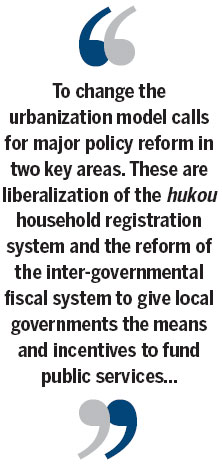New way needed to move labor
Updated: 2013-06-14 09:33
By Louis Kuijs (China Daily)
|
|||||||||||
Urbanization and greater consumerism require reforms to migrant workers system
Urbanization is one of the key focal points for economic reform in China at the moment. That is no surprise, as urbanization is a prime vehicle for growth by channeling people from low-productivity employment in agriculture to higher-productivity jobs and better living standards in the cities.
China has already seen a lot of urbanization. Annually some 10 million people have moved to urban areas over the past 20 years. At the end of last year, 52.6 percent of China's population was living in cities, up from 27.5 percent at the end of 1992.
 |
However, China has to see much more urbanization along the road to high-income status. Last year, a third of the labor force was still employed in agriculture, where productivity was less than a quarter of what it is in other parts of the economy, pointing to further supply of surplus labor.
But the role of urbanization and cities as engines of growth goes beyond absorbing surplus labor.
Cities permit economies of scale in production and distribution, and facilitate technology spillovers. Thanks to higher population densities in cities, private and public investments are more cost-effective and yield higher returns, and by bringing a critical mass of talent together in compact spaces, cities often become crucibles for innovation.
It is for these reasons that in developed countries the bulk of the population lives in cities. The average urban population size for a group of "high-income countries" last year was more than 80 percent.
However, the main reason for urbanization being actively discussed in Beijing now is different. China's urbanization model needs to change, in line with the rebalancing of its overall pattern of growth.
So far, urbanization has often meant migrants living in dormitories or dormitory-like circumstances, saving most of their income and sending the savings back to the countryside, where the rest of the family still lives. This traditional urbanization model efficiently supported export-oriented manufacturing, keeping costs low both for companies and for host local governments.
But the traditional model is running out of steam, and China's government wants to rebalance the pattern of growth toward a larger role for domestic consumption and services, away from the emphasis on investment, exports and industry.
This calls for a different approach to urbanization. China needs more full migration, with migrants able to take their family with them and to behave and spend like real urban citizens. As one person's spending on services is another person's income, this is a powerful feedback mechanism to foster more labor-intensive, services-oriented and consumption-based growth in an economically viable way.
To change the urbanization model calls for major policy reform in two key areas. The first area is liberalization of the hukou household registration system and the reform of the inter-governmental fiscal system to give local governments the means and incentives to fund public services such as health, education and social security, as well as affordable housing for migrants.
This requires a wholesale reform of inter-governmental relations to better match expenditure responsibilities with revenues, introduce new, stable revenue sources for local governments, and have more rules-based redistribution from richer areas to poorer ones via the center.
The second area is to clarify and improve land rights of rural households, and reform the process to convert rural land for urban use. The objectives are to increase the mobility of rural people, clarify and presumably raise the share of revenue gains from land sale going to rural households, and shift local governments' reliance on land sale revenues to other sources, including borrowing from domestic capital markets.
The author is the chief China economist at the Royal Bank of Scotland in Hong Kong.
(China Daily European Weekly 06/14/2013 page9)
Today's Top News
List of approved GM food clarified
ID checks for express deliveries in Guangdong
Govt to expand elderly care
University asks freshmen to sign suicide disclaimer
Tibet gears up for new climbing season
Media asked to promote Sino-Indian ties
Shots fired at Washington Navy Yard
Minimum growth rate set at 7%
Hot Topics
Lunar probe , China growth forecasts, Emission rules get tougher, China seen through 'colored lens', International board,
Editor's Picks

|

|

|

|

|

|





